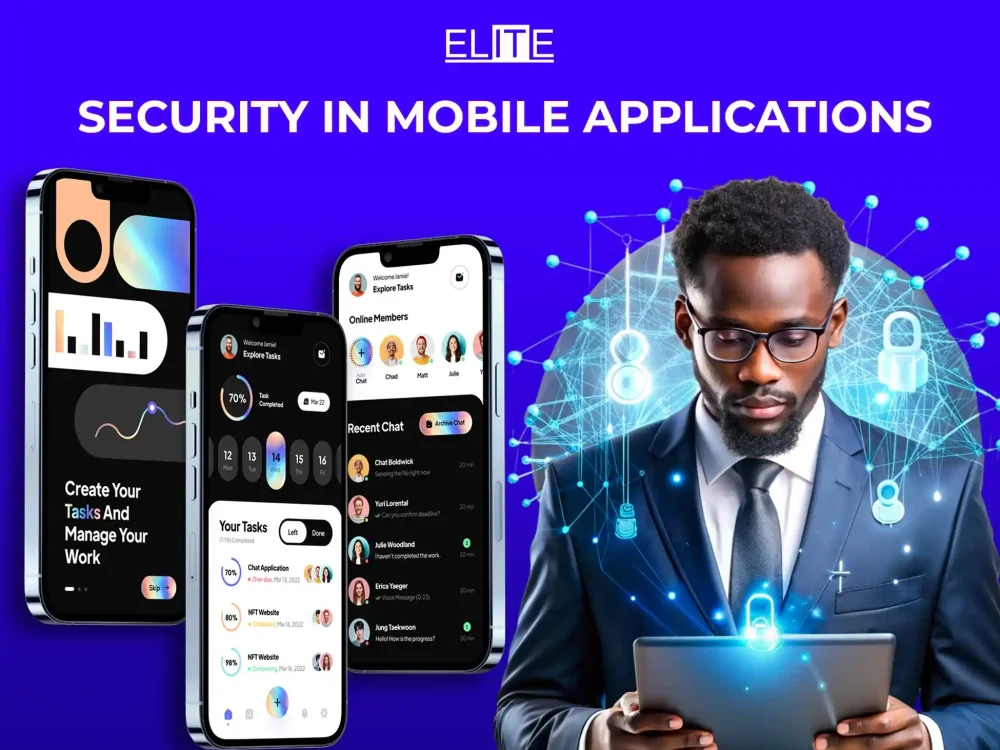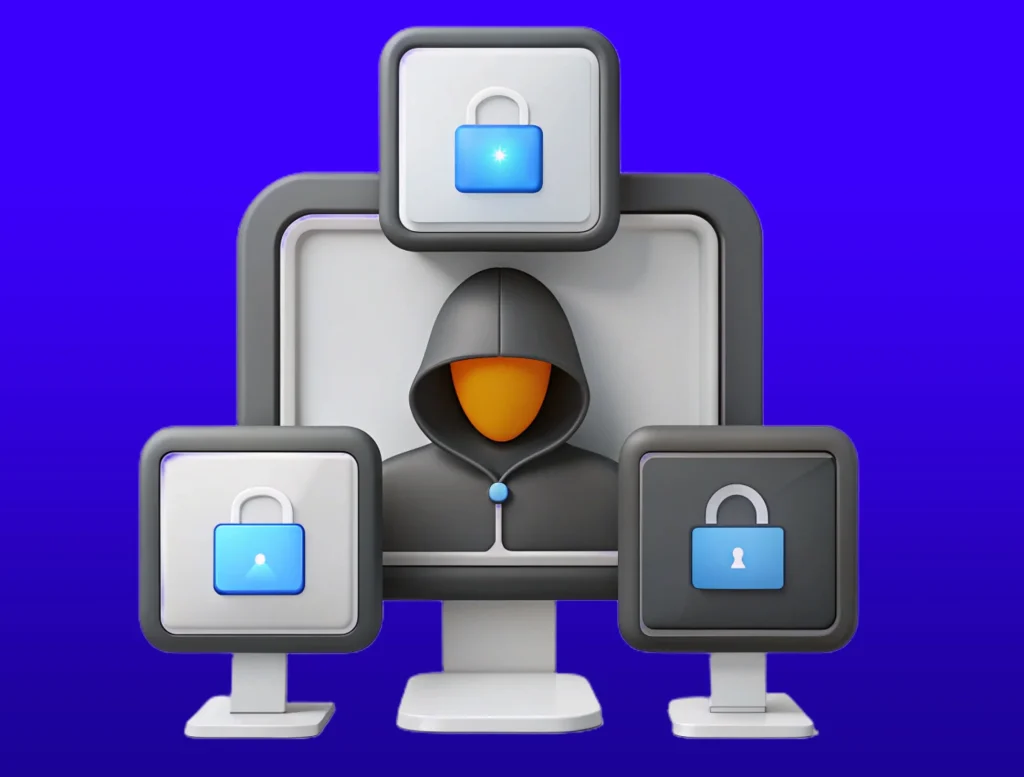Why Security in Mobile Applications is Essential For Businesses in 2024

What if one day your mobile app gets hacked? Suddenly, all your customers’ personal data is in the wrong hands, and your business takes a massive hit. Sounds like a nightmare, right? Well, with the rise of cyberattacks, this is becoming more of a reality for businesses every day. From data breaches to malware attacks, the need for security in mobile applications has never been more important. As an IT service provider, we at Elite IT Team, understand these challenges, which is why we offer top-notch cybersecurity solutions to keep your business safe. See, we’ve got you covered!
As we dive deeper into this blog, we’re going to explore the most common threats your mobile app might face, like malware attacks, data leaks, and insecure code. But don’t worry—we’ve got your back! We’ll also go over the best practices you can follow to make sure your app is as secure as possible. At Elite IT Team, we provide custom mobile application development services that prioritise security, ensuring your business stays protected in this ever-evolving digital landscape. Stick around for practical tips to safeguard your mobile apps!
What Are The Growing Threats in Security For Mobile Applications:
When it comes to security in mobile applications, the threats are getting more serious by the day. Cybercriminals are finding new ways to exploit weak spots, from sneaky malware to phishing attacks disguised as innocent notifications. If your app isn’t built with security in mind, it’s like leaving the front door of your business wide open. No one wants that, right?
With the rise of AI in mobile apps, security threats have become even more complex, as AI can both detect and unintentionally introduce vulnerabilities. AI-driven mobile applications need robust security protocols to protect sensitive data, ensuring user safety and trust. Let’s break down the biggest threats you need to know about. Let’s break down the biggest threats you need to know about.
Malware Attacks in Mobile Applications:
A malware attack is when malicious software sneaks its way into your app, often disguised as something harmless, and causes chaos. It can steal sensitive data, corrupt files, or even take over your app entirely. For businesses, this can be a massive blow to mobile app security and user trust, leading to data breaches and financial loss.
With the increasing importance of mobile app security, keeping your app safe from these threats is crucial to protect both your users and your business. Regular security updates and thorough testing are essential to ensure your app doesn’t become a target for cybercriminals!
Third Party APIs:
Third-party APIs are tools created by other developers that help your app connect with external services—think payment gateways or social media logins. They’re super helpful for speeding up development and adding functionality without reinventing the wheel. But here’s the catch: they can also introduce vulnerabilities, especially when it comes to Android application security. If the API isn’t secure or updated regularly, it can be a weak link in your app’s defences.
To ensure mobile application protection, always vet your third-party APIs, use secure connections, and stay on top of any updates or patches. This way, you can enjoy the benefits without putting your app at risk.
Data Leakage:
Data leakage happens when sensitive information is unintentionally exposed to unauthorised parties. This can occur through various channels, such as weak data encryption, improper handling of user credentials, or vulnerabilities in the app’s code. For example, if an app stores user passwords in plain text rather than encrypting them, anyone who gains access to the database could easily steal those passwords.
This type of breach highlights the critical need for strong security in mobile applications to prevent unauthorised access and protect user data. As we look toward the future of mobile applications, prioritising data protection and employing best practices for data security will be key in maintaining user trust and ensuring your app remains a safe haven for sensitive information.
Insecure Authentication: Risks in Mobile Apps:
Insecure authentication is a big deal when it comes to mobile app security and privacy. It’s like having a flimsy lock on your front door—if your app uses a weak password policy to make logging in easier, or if it relies on features like TouchID without additional safeguards, you’re setting yourself up for trouble.
Weak passwords and overly simplified authentication methods can make it easy for hackers to gain unauthorised access, putting your users’ data at risk. To strengthen up your app’s security, implement strong password policies and multi-factor authentication. This way, you’re not just leaving the door open—you’re bolting it shut!
Weak Server-Side Controls:
Weak server-side controls are a major vulnerability when it comes to security in Android apps. If the backend servers managing your app’s data aren’t properly secured, hackers can easily exploit them to gain access to sensitive information or even take down your entire system. It’s like having a high-tech app but leaving the server door wide open for anyone to walk in.
So, what is mobile application security without strong server-side defences? Not much! To protect your app, you need to ensure that your servers are equipped with encryption, proper authentication, and regular security patches. By strengthening your server-side controls, you can shield your app from potential threats and keep your users’ data safe.
What are the Best Practices For Securing Your Mobile Applications?
Securing your mobile applications is like locking up your house every night—it’s essential for keeping intruders out and protecting your valuables. To ensure top-notch security in mobile applications, following best practices are crucial. Let’s dive into the strategies that will help fortify your app and keep it safe from potential threats.
Implementing Strong Authentication: Key Methods For Security
When it comes to how to secure mobile applications, strong authentication is your first line of defence. A strong password is one that’s not just easy to remember but hard to guess—think a mix of uppercase letters, lowercase letters, numbers, and special characters. For example, “P@ekl0Td132!” might be a strong password, but adding complexity and avoiding common words is even better.
Beyond just strong passwords, incorporating multi-factor authentication (MFA) can add an extra layer of security. MFA requires users to provide additional verification, like a code sent to their phone or a fingerprint scan, making it much harder for unauthorised access. As mobile application trends evolve, staying ahead with these security measures will help ensure your app remains protected against emerging threats.
Data Encryption: Securing Information
Data encryption is the process of converting sensitive information into a code to prevent unauthorised access. It ensures that even if data is intercepted, it remains unreadable without the proper decryption key.
To enhance your mobile app security checklist, consider these key measures:
- Two-Factor Authentication (2FA): Adds an extra layer of security by requiring a second form of verification, such as a code sent to the user’s phone.
- App Shielding Techniques: Protects your app from reverse engineering and tampering, safeguarding against vulnerabilities.
- Security Threat Monitoring: Continuously tracks potential threats and vulnerabilities to respond quickly and mitigate risks.
By implementing these practices, you strengthen the security in mobile applications and ensure your data stays safe and sound.
Secure Code Development: Ensuring Best Practices for Safety
Secure code development is crucial for maintaining security in mobile applications. It involves a range of practices designed to protect your code from vulnerabilities and attacks. Key techniques include performing thorough input validation to prevent injection attacks, managing memory carefully to avoid leaks and buffer overflows, and steering clear of insecure C functions that can compromise your app. Additionally, avoid using immutable containers for storing sensitive data to reduce the risk of data exposure. This is just a subset of the extensive best practices recommended by various platforms.
When considering native vs. cross-platform app development, it’s essential to apply secure coding practices to both. Native development offers more control over security features specific to each platform, while cross-platform solutions require extra diligence to ensure consistent security across different environments. By following these best practices, you can improve your app’s defences and enhance its overall safety.
Regular Security Updates: Why They’re Crucial for Safety
Regularly applying updates and patches is fundamental to maintaining a secure mobile environment, as it helps safeguard against evolving cyber threats. As Serhat Ömer Rencber, Ph.D., points out, updates and patches are software modifications that address security vulnerabilities, fix bugs, and add new features. Without these regular updates, your app can become a playground for hackers, putting user data at serious risk.
For both iOS app security and Android, keeping up with the latest patches is non-negotiable. By staying on top of security updates, you’re not only protecting your users but also ensuring your app continues to run smoothly and securely. Don’t leave your app exposed—make those updates a priority!
Powerful APIs: How They Transform Application Development
Powerful APIs (Application Programming Interfaces) play a huge role in transforming mobile app development by allowing apps to communicate with external services and platforms seamlessly. They streamline the development process, adding complex features like payment processing, cloud storage, and communication tools without the need to build them from scratch.
Popular APIs like Salesforce for customer relationship management, Slack for team communication, PayPal for secure payments, and Cisco for networking solutions are widely used to enhance app functionality. By integrating these APIs, developers can create more efficient, scalable, and feature-rich apps while maintaining strong security in mobile applications.
Final Words:
In today’s digital world, security in mobile applications is no longer optional—it’s a necessity. From combating malware attacks and data leaks to ensuring secure authentication and regular updates, keeping your app protected should always be a top priority. Implementing strong authentication, encrypting sensitive data, and using secure coding practices are just a few of the essential steps in building a safe app. With APIs adding powerful functionality and server-side controls reinforcing security, your mobile app must be fortified to handle modern threats.
For businesses, securing mobile apps isn’t just about protecting data—it’s about maintaining trust and credibility with your users. If you’re looking for a secure, high-performance app, Elite IT Team is here to help! We offer tailored solutions to ensure your app is built with the highest security standards. Contact us today and let us take care of your mobile application security needs!
Table of Contents
Frequently Asked Questions:
Organisations can utilise a range of application security tools, services, and devices to safeguard their systems. Firewalls, antivirus software, and data encryption are some common methods to block unauthorised access.
Mobile app security involves protecting valuable mobile applications and your digital identity from various types of malicious attacks. This includes safeguarding against tampering, reverse engineering, malware, keyloggers, and other forms of manipulation or intrusion.
Common mobile app security threats include a range of vulnerabilities that can compromise the safety of your app and user data. These threats often arise from malicious files or links, data breaches, and improper authentication methods. Weak encryption and the use of malicious mobile code can further expose apps to risks. Additionally, vulnerable networks, rooted or jailbroken devices, and insecure data transmission are other critical security challenges that apps must address to ensure a secure environment for users.

Zara Finch
Zara, an experienced professional in the SEO industry for the past two years, is passionate about discussing technology, innovations, and the ever-evolving digital landscape. With a keen interest in exploring the latest trends and developments, she brings valuable insights and expertise to her work.











